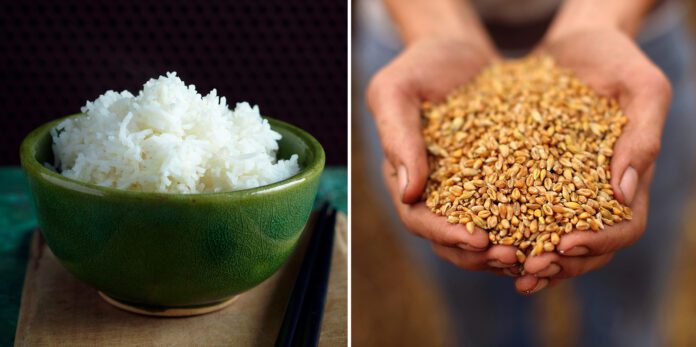Wheat Vs. Rice – Which is Better? | Nutritional Comparison Between Wheat & Rice: These days everyone wants to be healthy and wants to choose the right nutritional diet so that he can stay fit and healthy. So in this scenario of choosing the right nutritional diet, a very common question arises about wheat and rice “Which One is Better?” Both wheat and rice are probably two of the best cereal grains in the world right now, and they have been the main ingredients in terms of staple dishes for ages.
If you are someone who prefers eating whole grains, going with rice and wheat is the most suitable option to satisfy your nutritional needs because both are exceptional if we talk about nutrition.
However, there are some differences when it comes to Wheat Vs. Rice, and in today’s article, we are going to talk about the calories, protein and fats, carbohydrates, vitamins, minerals, glycemic index, and acidity of both these cereal grains.
Moreover, at the end of the article, we’ll also analyze which is better, “Wheat Vs. Rice”.
Shall we start? Let’s get off the ground:
What is the difference between wheat and rice?
Here is a comprehensive comparison of the differences between wheat and rice:
Scientific Name:
Wheat: Triticumaestivum
Rice: Oryza sativa (Asian rice) Or Oryzaglaberrima (African rice)
Staple Diet:
Wheat: The people of North Africa, the Middle East, and the developed Western nations, include wheat as a staple food in their diets.
Rice: The majority of developing nations, including those in Asia and Africa, eat rice as a staple food.
Gluten-Free Diet:
Wheat: People following a gluten-free diet should avoid wheat.
Rice: People following a gluten-free diet can eat rice.
Starch Content:
Wheat: Wheat has a lower starch content than rice, at about 70%.
Rice: Compared to wheat, rice has a lower starch concentration (about 80%).
Protein Content:
Wheat: Compared to rice, wheat has a higher protein level (10–15%).
Rice: Compared to wheat, rice has a lower (5–10%) protein level.
Nutritional comparison of Wheat Vs. Rice
Wheat Vs. Rice Calories
Both are high-calories foods, which is why it is recommended to rely on these cereal grains in order to satisfy dietary needs.
On average, wheat has around three times more calories compared to rice.
100 grams of rice: 130 Calories
100 grams of wheat: 339 Calories
Wheat Vs. Rice Protein and Fats
Proteins and fats are in higher proportion in wheat. When compared to rice, wheat has approximately 4x more proteins.
All of the necessary amino acids are present in the same amount in wheat and rice. Histidine, phenylalanine, and tryptophan are very abundant in wheat.
Grain products like wheat and rice have low fat. All three types of fats—polyunsaturated, monounsaturated, and saturated—are in roughly equal amounts in rice. Contrarily, wheat contains more polyunsaturated and monounsaturated fats.
These two grains don’t have cholesterol.
Wheat Vs. Rice Cholesterol
Carbohydrates are in higher proportion in both wheat and rice. This is primarily due to the high levels of starch and dietary fiber.
Wheat Vs. Rice Vitamins
The majority of B-group vitamins are commonly found in grains.
Higher concentrations of vitamins B1, B2, B3, B5, and B6 can be found in wheat grains.
The folic and folate forms of vitamin B9 are more abundant in enriched white rice. Wheat does not have vitamin E, but rice does.
Vitamins A, D, K, C, and B12 are entirely absent from both wheat and rice.
Wheat Vs. Rice Minerals
With higher concentrations of all the major minerals—iron, calcium, copper, potassium, phosphorus, magnesium, manganese, zinc, and selenium—wheat is the obvious victor when we talk about minerals.
Additionally, rice has twice as much salt as wheat.
Wheat Vs. Rice Glycemic Index
Grains vary in their glycemic index according to variety, dietary fiber content, and cooking technique.
Boiled white arborio risotto rice has a glycemic index of 69±7, according to The International Tables of Glycemic Indices. However, the average glycemic index of boiling white rice is 7±28, according to five separate research. The glycemic index of boiled long-grain rice is only 60±3, making it a healthier option. White basmati rice has a glycemic index of 57±4.
The average of three investigations yields a glycemic index of 45 for whole wheat kernels. Both raw and cooked durum wheat have glycemic indices in the 50±5 range.
While wheat has a low glycemic index, white rice is often in the medium to high range.
Wheat Vs. Rice Acidity
There is a mild acidity to rice. Even though the exact pH range for rice might change from variety to variety, most rice falls somewhere between 6 and 7. The pH range for white rice is between 6 and 6.7, whereas that for brown rice is between 6.2 and 6.7.
Wheat has a little bit more acidity. Whole wheat has a pH of 5.8.
The potential renal acid load (PRAL) is an alternate acidity measurement that shows how much acid or base the supplied diet produces in the body.
According to our calculations, wheat and rice have PRAL values of 12.3 and 1.7, respectively. Therefore, while both foods contain acid, wheat has a more acidic effect.
Rice Vs. Wheat Nutrition Chart
As we have discussed the comparison of wheat and rice in relation to calories, proteins, fats, carbs, minerals, vitamins, glycemic index, and acidity, here is a nutrient comparison chart that shows the exact differences between the staple grains “Wheat Vs. Rice”.
Wheat Vs. Rice - Nutritional Comparison Table
| Nutrients | Rice | Wheat |
| Net Carbs | 27.77g | 71.13g |
| Protein | 2.69g | 13.68g |
| Fats | 0.28g | 2.47g |
| Carbs | 28.17g | 71.13g |
| Calories | 130kcal | 339kcal |
| Sugar | 0.05g | g |
| Fibre | 0.4g | g |
| Calcium | 10mg | 34mg |
| Iron | 1.2mg | 3.52mg |
| Magnesium | 12mg | 144mg |
| Phosphorus | 43mg | 508mg |
| Potassium | 35mg | 431mg |
| Sodium | 1mg | 2mg |
| Zinc | 0.49mg | 4.16mg |
| Copper | 0.069mg | 0.553mg |
| Vitamin E | 0.04mg | mg |
| Vitamin B1 | 0.163mg | 0.419mg |
| Vitamin B2 | 0.013mg | 0.121mg |
| Vitamin B3 | 0.121mg | 6.738mg |
| Vitamin B5 | 0.39mg | 0.935mg |
| Vitamin B6 | 0.093mg | 0.419mg |
| Folate | 58µg | 43µg |
| Tryptophan | 0.031mg | 0.176mg |
| Threonine | 0.096mg | 0.366mg |
| Isoleucine | 0.116mg | 0.533mg |
| Leucine | 0.222mg | 0.934mg |
| Lysine | 0.097mg | 0.303mg |
| Methionine | 0.063mg | 0.221mg |
| Phenylalanine | 0.144mg | 0.681mg |
| Valine | 0.164mg | 0.594mg |
| Histidine | 0.063mg | 0.322mg |
| Saturated Fat | 0.077g | 0.454g |
| Monounsaturated Fat | 0.088g | 0.344g |
| Polyunsaturated fat | 0.076g | 0.978g |
Which is Better Wheat Vs Rice?
All nutrients, including protein, lipids, carbs, the majority of minerals, and the majority of vitamins, are more abundant in wheat. However, rice has more starch, saturated fats, vitamin B9, and vitamin E than other grains. So, wheat is more nutrient-dense than rice.
Summary
There it is—a thorough analysis of the differences between Wheat Vs. Rice. It will be simpler for you to choose which one suits you based on your body’s needs and personal preferences now that you fully comprehend their primary distinctions and nutritional makeups.
Do you have any other knowledge that might be used to compare wheat and rice? Comment below and let us know.
FAQs – Wheat Vs. Rice
The foods’ cholesterol content is essentially the same (0 mg). Rice: Rice contains less saturated fat (difference – 0.377g) Rice: Rice has lower sodium levels (Difference – 1mg) Wheat: Wheat is comparatively more mineral-rich. Wheat: Wheat is less expensive ($0.6 Difference). Wheat: The glycemic index of wheat is lower (Difference – 10) Wheat: Wheat contains less sugar (Difference – 0.05g)
Wheat Vs. Rice – Which One has the Lowest Cholesterol Content?
Wheat Vs. Rice – Which Dish Has the Least Saturated Fat?
Wheat Vs. Rice – Which One has the Least Sodium?
Wheat Vs. Rice – Which One Contains More Minerals?
Wheat Vs. Rice – Which One is Less Expensive?
Wheat Vs. Rice – Which One has Lower Glycemic Index?
Wheat Vs. Rice – Which Contains Less Sugar?







